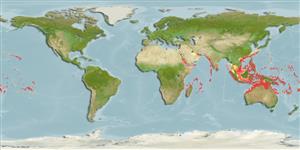Actinopterygii (ray-finned fishes) >
Perciformes (Perch-likes) >
Serranidae (Sea basses: groupers and fairy basslets) > Epinephelinae
Etymology: Cephalopholis: Greek, kephale = head + Greek, pholis = scale (Ref. 45335).
Environment / Climate / Range
Ecology
Marine; reef-associated; non-migratory; depth range 6 - 150 m (Ref. 9710). Tropical, preferred ?; 34°N - 23°S, 31°E - 138°W (Ref. 5222)
Indo-Pacific: Red Sea to South Africa and eastward to French Polynesia. Reported from the Arafura Sea (Ref. 9819). Reports by Heemstra & Randall (1984, Ref. 3153) from the Gulf of Oman, Pakistan, India, and Sri Lanka are unsubstantiated. Absent from the Persian Gulf and is not yet known from Lakshadweep Islands.
Size / Weight / Age
Maturity: Lm ? range ? - ? cm
Max length : 50.0 cm TL male/unsexed; (Ref. 11441); max. published weight: 7.0 kg (Ref. 30874)
Dorsal
spines
(total): 9;
Dorsal
soft rays
(total): 14-16;
Anal
spines: 3;
Anal
soft rays: 9. Characterized by orange-red color with six brown saddles/bars on side with pale areas in between; head, body and fins with small blue spots; body scales ctenoid, including abdomen; greatest depth of body 2.6-3.1 in SL; rounded caudal fin; pelvic fins, 1.9-2.3 in head length (Ref. 90102); interorbital area flat to slightly convex; dorsal head profile of large specimens distinctly concave above eyes; rounded preopercle, finely serrate in young, virtually smooth in large adults, lower edge fleshy; small serrae in subopercle and interopercle mostly hidden by skin; scaly maxilla, reaching past eye (Ref. 089707).
Found in rich coastal to outer reefs, usually along deep walls with caves, rich with invertebrate growth such as large sponges or soft corals (Ref. 48635). A secretive species. Active nocturnally in shallow water and diurnally in deeper water (Ref. 5222). Often seen with the cleaner shrimp Periclimenes elegans (Ref. 37816). Feeds mainly on fishes (Ref. 5222). Solitary or in small groups (Ref 90102). Reaches sexual maturity at 25 cm SL (Ref. 089707).
Life cycle and mating behavior
Maturity | Reproduction | Spawning | Eggs | Fecundity | Larvae
Heemstra, P.C. and J.E. Randall, 1993. FAO Species Catalogue. Vol. 16. Groupers of the world (family Serranidae, subfamily Epinephelinae). An annotated and illustrated catalogue of the grouper, rockcod, hind, coral grouper and lyretail species known to date. Rome: FAO. FAO Fish. Synop. 125(16):382 p. (Ref. 5222)
IUCN Red List Status (Ref. 115185)
CITES (Ref. 94142)
Not Evaluated
Threat to humans
Harmless
Human uses
Fisheries: subsistence fisheries; gamefish: yes
More information
Common namesSynonymsMetabolismPredatorsEcotoxicologyReproductionMaturitySpawningFecundityEggsEgg development
ReferencesAquacultureAquaculture profileStrainsGeneticsAllele frequenciesHeritabilityDiseasesProcessingMass conversion
Tools
Special reports
Download XML
Internet sources
